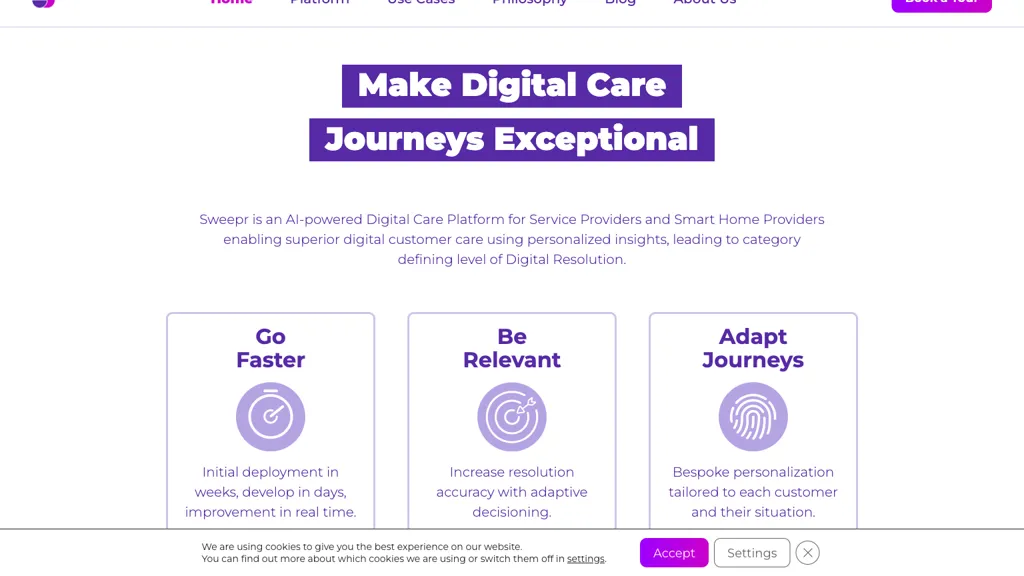What is Sweepr?
Sweepr is the AI-powered connected home technology digital care platform for service providers and smart home companies. The goal is to provide great digital customer care through personal insights with unparalleled levels of issue resolution. It reduces weeks of mobile development work for organizations into an effort completed in days with real-time enhancements.
It is equipped with adaptive decision-making, tailored personalization features, and customized customer journey adaptations. Implementation time on Sweepr is improved, the creation and updating of workflows are eased, customer call length is reduced, resolution rates are on the higher end, and operational efficiencies are improved.
Key Features and Benefits of Sweepr
Sweepr is home to loads of features and benefits that viewers variedly find useful. Some facts and features among them are:
Personalized insight capabilities for digital customer care, adaptive decisioning, bespoke personalization at the level of the individual, omnichannel support, and generative AI functionalities are the headliners. Among them are things like faster deployment timeframes, improved customer care experiences, reduced customer calls, and higher operational efficiency. Some of its main advantages include real-time enhancements and the ability for personalization within user journeys.
Sweepr Use Case and Application
Leverage Sweepr’s advanced analytics to analyze and optimize the customer journey across multichannel to get many ideas for ideal customer satisfaction and excellence in issue resolution. The Sweepr Generative AI technology automates issue resolution to reduce implementation time and drive improvements in operational efficiency.
Sweepr’s omnichannel support can be integrated to help organizations extend customer self-service options for a seamless experience at all contact points. Such integration drastically reduces the time for customer calls, so the issue is resolved in no time at all, which puts the customer in a good mood.
How to Use Sweepr
Using Sweepr involves a very simple process, structured and designed to help users derive maximum efficiency and benefit from the platform. The steps are described one by one in the following lines:
- Firstly, set up the Sweepr platform within the existing infrastructure of the organization.
- Personalize the platform according to your needs and objectives of customer care.
- Use adaptive tools of decision-making to design a customized customer journey.
- Leverage the generative features of AI to automate routine interchanges and remedies for the customers.
- Analyze and follow all the customers’ activities with the help of deep analytic tools of Sweepr to make constant iterations and further refine customer experience.
Best practices are bringing in regular updates and changes on the platform with the insights of real-time data and feedback to the system for remaining effective and useful.
How Sweepr Works
Sweepr operates on a high level of AI and ML. Indeed, the platform personalizes customers’ information and interaction through the use of the most complex algorithms for smarter decisions made in enhancements to their journey. In most cases, the workflow will involve data collection, analysis, decision-making, and execution of personalized customer care strategies.
The AI capabilities of Sweepr enable common customer service tasks to be automated, in turn releasing human agents to deal with any complex issues. As a result, it provides customers with shorter resolution times and more efficiency in the customer care process.
Sweepr Pros and Cons
Now, as with all platforms, Sweepr has both its pros and potential cons. Some of the pros that come with it are:
- There is a massive reduction in the deployment timelines.
- It enhances personalization and adaptive decision-making.
- Comprehensive support is offered across multi-channels.
- Better operational efficiencies and resolution rates.
Disadvantages may include:
- Initial setup and configuration needed.
- Organizations might need to micromanage activities because it’s not very easy to depend on intellectual knowledge-based AI agents for significant customer interactions.
User Reviews about Sweepr appear to highlight the fact that the solution has been a game-changer in the customer care processes leading to a boost in customer satisfaction levels far above industry standards.
Sweepr Conclusion
In other words, as a potent digital care platform enabled with AI, Sweepr provides improvement from the norm of the marketplace in terms of reduction in deployment time and customer care experiences with personalized insights. Other features unique to the platform include generative AI and omnichannel support—all aspects that make the product valuable to service providers and smart home providers.
Future developments are likely to incorporate enhancements that will amplify Sweepr’s functionalities, making it an even more invaluable tool for the optimization of digital customer care.
Sweepr FAQs
Q: What is Sweepr?
A: Sweepr is an AI-based digital care platform established for service and smart home providers in their mission to improve digital care using dynamic comfort and personalized insights.
Q: What features does Sweepr come with?
A: The main features are: personalized insights, adaptive decision-making, precise personalization, omnichannel support, and generative capacities in AI.
Q: How is Sweepr an advantage to my organization?
A: It will deliver reduced implementation periods, reduced duration of customer calls, increased resolution rates, shortened workflows, and overall increased operational efficiencies.
Q: Who uses Sweepr?
A: Sweepr is used by service providers or smart home providers to maximize customer care processes.
Q: How does it work?
A: Sweepr enables the analysis of customer interaction using advanced AI and machine learning algorithms. It helps in making adaptive decisions and automating the resolutions through generative AI capabilities.
Q: What are some pros and cons of Sweepr?
A: Reduced deployment times, increased personalization, and improved efficiencies are some of the pros. Some cons may be the basic setup required or the dependency on AI for critical interactions.










